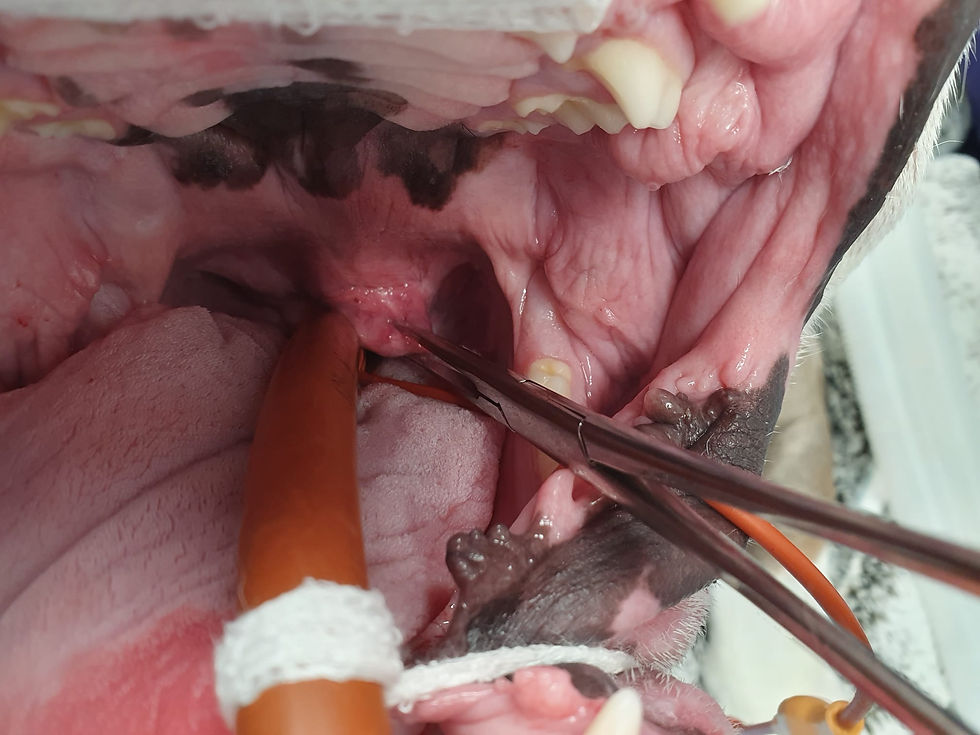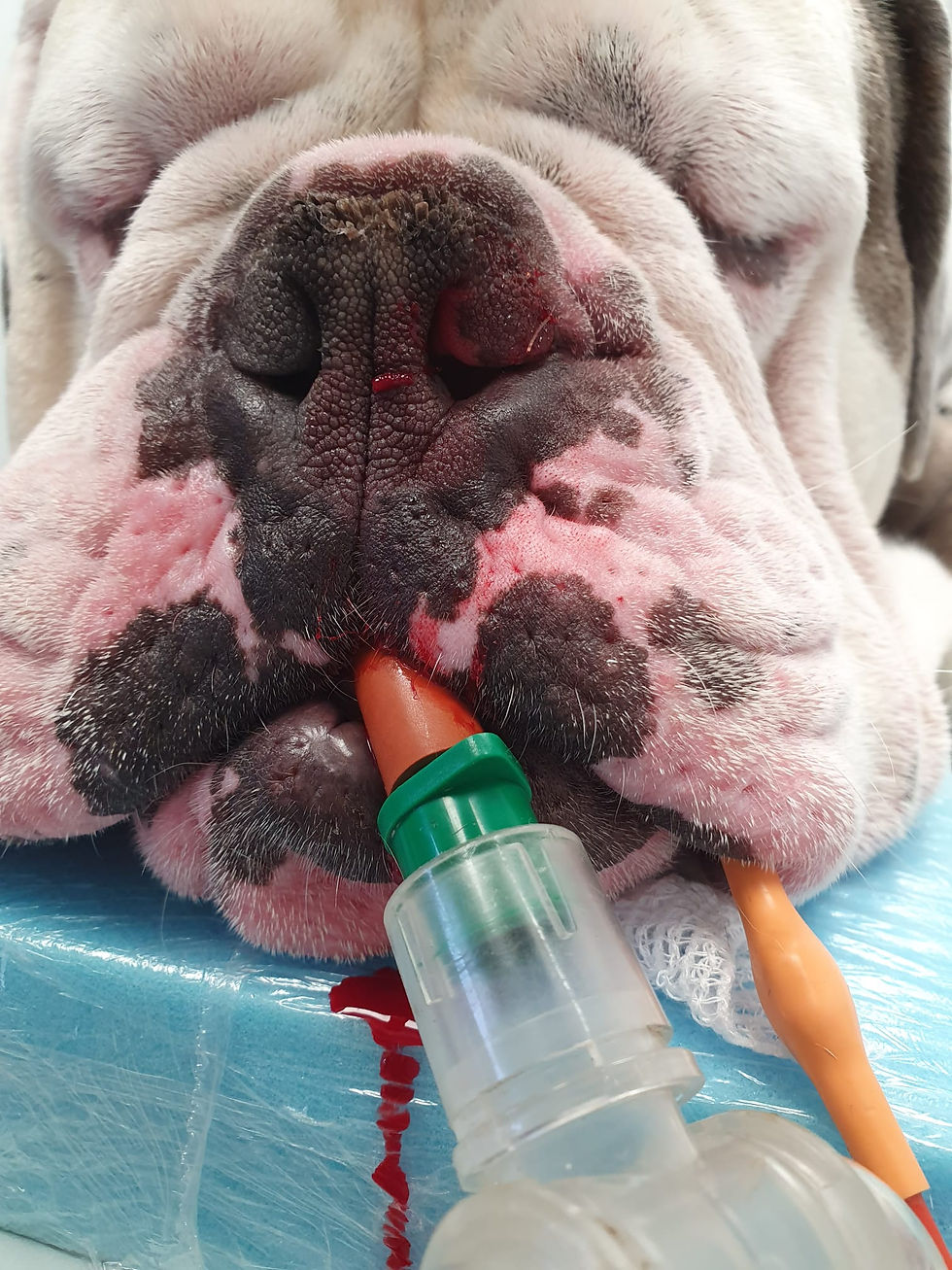BOAS surgery in brachycephalic dogs
- crownvets
- Aug 7
- 3 min read
Brachycephalic dogs—those with short, flattened faces such as Bulldogs, Pugs, French Bulldogs, and Boston Terriers—are beloved for their unique appearance and charming personalities. However, this distinctive anatomy means they are prone to a number of breathing problems known as Brachycephalic Obstructive Airway Syndrome (BOAS).
BOAS surgery is a vital intervention for many affected dogs, offering the chance for a better quality of life. In this blog we will look at causes and symptoms and how surgery can drastically improve quality of life for these patients.
Causes and Symptoms
BOAS arises due to the anatomical structure of brachycephalic breeds. Selective breeding for a shortened skull has led to overcrowding in the airway. The main anatomical abnormalities that contribute to BOAS include:
· Nostril stenosis (stenotic nares): Narrowed nostrils restrict airflow.
· Elongated soft palate: The palate extends too far backward, partially blocking the windpipe.
· Everted laryngeal saccules: Tissue just in front of the vocal cords is pulled into the airway due to increased breathing effort.
· Hypoplastic trachea: A windpipe that is smaller in diameter than normal.
Dogs suffering from BOAS often present with the following symptoms:
· Noisy breathing or snoring
· Exercise intolerance or collapse after physical activity
· Difficulty eating or swallowing
· Gagging or retching
· Cyanosis (blue-tinged gums/tongue)
· Heat intolerance
· Frequent respiratory infections
BOAS is not only a quality of life issue but can be life-threatening, especially during periods of excitement, stress, or hot weather.
Diagnosis of BOAS
The diagnosis of BOAS is based on a combination of clinical signs, breed predisposition, and physical examination. A veterinarian will assess the dog's breathing and may perform tests under sedation or anaesthesia to visualize the airway structures. In some cases, advanced imaging (such as CT scans or endoscopy) is used to evaluate the extent of obstruction. As with most things early intervention is important in achieving a positive outcome.
Indications for Surgery
Not all brachycephalic dogs with BOAS require surgery. Mildly affected dogs may be managed with weight control, lifestyle modifications, and environmental management (such as avoiding heat and stress). However, dogs with moderate to severe symptoms, especially those with exercise intolerance, frequent respiratory distress, or collapse, are strong candidates for surgical intervention.
Surgical Procedures in BOAS Management

BOAS surgery is tailored to the individual's anatomical abnormalities and may involve one or more of the following procedures:
Stenotic Nares Resection
This procedure widens the nostrils to allow easier airflow. Several techniques exist, including wedge resection or punch excision, where portions of tissue are removed and the nostril is sutured to maintain a larger opening.
Soft Palate Resection (Staphylectomy)

Elongation of the soft palate is corrected by trimming the excess tissue so it no longer obstructs the windpipe. This is often performed using scalpels, scissors, or laser surgery to minimize bleeding and swelling.
Laryngeal Saccule Excision
Everted laryngeal saccules are removed to reduce airway obstruction and improve breathing.
Other Procedures
In more advanced cases, or when secondary changes have occurred, surgeries may include tonsillectomy (removal of inflamed tonsils) or more advanced laryngeal surgeries. In rare instances, a permanent tracheostomy may be considered for dogs with severe, irreversible airway collapse.
The Surgical Process: What to Expect
BOAS surgery is performed under general anaesthesia, which carries an increased risk for brachycephalic dogs due to their compromised airways. Pre-operative stabilization may include oxygen therapy, sedation, and anti-inflammatory medications.
The procedures typically take between 30 minutes and 2 hours, depending on the complexity and combination of surgeries performed.
Risks and Complications
As with any surgical intervention, BOAS surgery carries an element of risk which your surgeon will discuss with you beforehand. There is also a risk that a degree of respiratory may remain. However in experienced hands and with appropriate post-operative care, the majority of dogs recover well and experience significant improvement in quality of life.
Post-Operative Care and Recovery
Immediate post-surgical care focuses on minimizing swelling and monitoring for breathing difficulty. Dogs are often kept calm and may receive steroids or anti-inflammatories, pain relief, and sometimes antibiotics.
The recovery period lasts from several days to two weeks. During this time, owners must:
· Keep the dog quiet and calm, avoiding excitement or vigorous activity
· Feed softened food to reduce throat irritation
· Monitor for signs of respiratory distress (laboured breathing, blue gums, excessive panting)
· Attend follow-up veterinary appointments for suture removal and assessment

Long-term, weight management and avoiding overheating remain crucial. Even after successful surgery, brachycephalic dogs should not be overexerted during hot or humid weather.
BOAS surgery represents a life-changing intervention for many brachycephalic dogs struggling with breathing difficulties. By understanding the causes, procedures, and aftercare involved, owners can make informed decisions to support their pet’s health and happiness. Ultimately, a combination of surgical management, responsible breeding, and lifelong care offers the best hope for these unique and endearing companions.




Comments